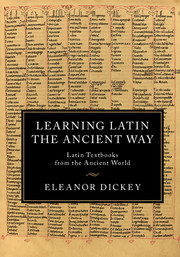4 - Glossaries
Published online by Cambridge University Press: 05 March 2016
Summary
Ancient learners used a variety of types of glossary. One of these was the alphabetically arranged dictionary, like those commonly used today; this format is attested from the second century ad for bilingual glossaries (and much earlier for Greek–Greek glossaries) but was never very popular in antiquity. Another type was the author-specific word list, a running list of the hard words occurring in a particular text with their definitions. Again this format is attested much earlier for Greek–Greek glossaries (particularly those to Homer and Hippocrates) than for Latin–Greek or Greek–Latin ones, but from the fourth century it gained popularity as a way of presenting Virgil vocabulary for students reading the Aeneid.
The most common type of glossary was the classified word-list; these works were arranged into sections (known as capitula, “little chapters”) of words relating to different topics. Classified glossaries were primarily used not for finding the meanings of unfamiliar words (a function for which they are by nature not as well suited as alphabetical or text-order glossaries) but for systematic vocabulary building: students memorized the different sections one after another to improve their vocabulary knowledge. Classified glossaries are attested from the first or second century ad, making them the earliest type of bilingual glossary known; they were also the earliest type of monolingual Greek glossary, going back at least to the Alexandrian scholar Aristophanes of Byzantium (ca. 257–ca. 180 bc).
Most ancient glossaries contained only the words themselves, without any of the information on usage or inflection that is a standard feature of today's dictionaries. There are, however, some interesting exceptions to this principle, and some of those exceptions are very early: the earliest known papyrus fragment of a bilingual glossary, from the first century bc, contains a considerable amount of grammatical information. It looks as though the earliest phase of production of Latin-learning materials may have tended to combine grammatical and lexical information, which later became separated as the field expanded and works became more specialized. The text in 4.4 below is one of the relatively early texts preserving the integrated format; the others come from the more developed tradition.
- Type
- Chapter
- Information
- Learning Latin the Ancient WayLatin Textbooks from the Ancient World, pp. 100 - 115Publisher: Cambridge University PressPrint publication year: 2016



